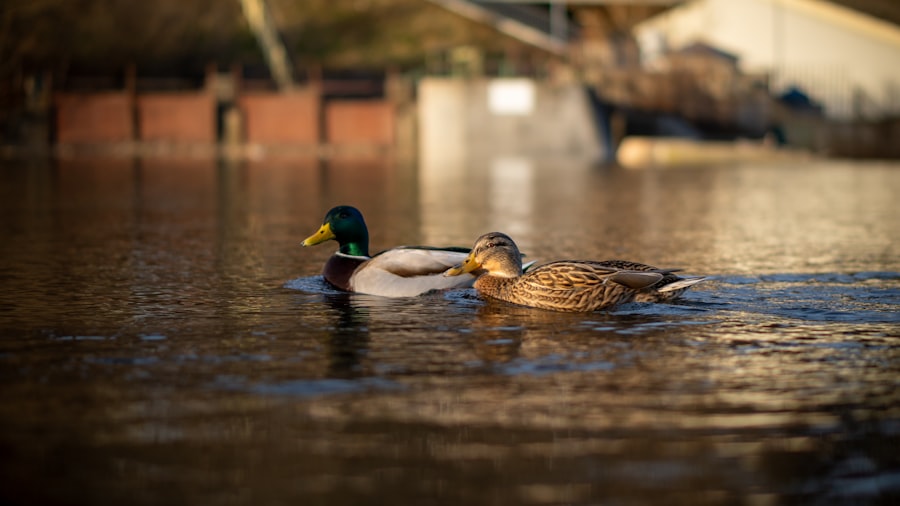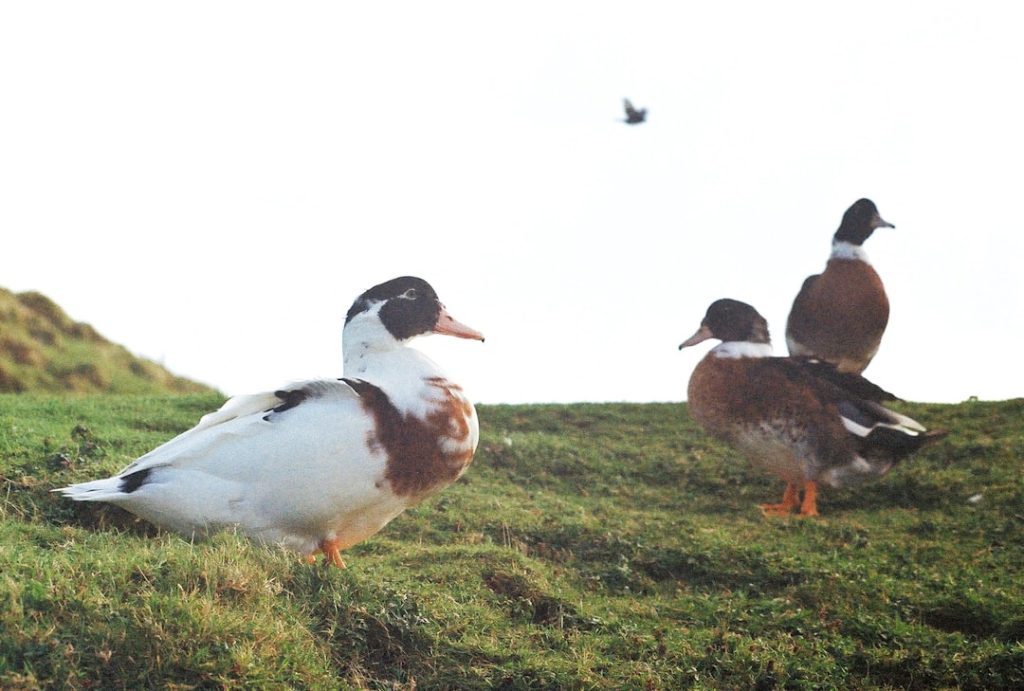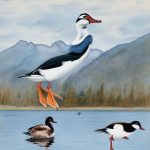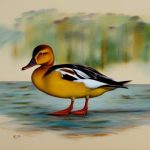Wild duck breeds are a diverse group of waterfowl that belong to the family Anatidae. These birds are known for their beautiful plumage, webbed feet, and distinctive quacking sound. There are many different species of wild ducks, each with its own unique characteristics and behaviors. Some of the most well-known wild duck breeds include the mallard, wood duck, teal, and pintail.
Wild ducks can be found in a variety of habitats, including freshwater lakes, rivers, marshes, and coastal estuaries. They are highly adaptable birds and can be found on every continent except Antarctica. Wild ducks play a crucial role in the ecosystem, as they help to control insect populations, disperse seeds, and provide food for predators such as foxes and eagles. In addition to their ecological importance, wild ducks are also popular game birds and are often hunted for sport and food.
Table of Contents
Key Takeaways
- There are several wild duck breeds, each with unique characteristics and behaviors.
- Wild duck breeds can be found in a variety of habitats and have different distribution patterns around the world.
- Wild duck breeds exhibit diverse mating habits and behaviors, contributing to their importance in the ecosystem.
- The conservation status of wild duck breeds varies, with some facing threats and challenges to their survival.
- Understanding the importance of wild duck breeds in the ecosystem is crucial for their conservation and preservation.
Characteristics of Wild Duck Breeds
Wild duck breeds come in a wide range of sizes and colors, with males typically being more brightly colored than females. Male ducks, known as drakes, often have vibrant plumage with iridescent green or blue heads, while females, known as hens, have more muted brown or gray feathers for camouflage. Many wild duck breeds also have distinctive markings on their wings, such as the white speculum on the mallard and the colorful patches on the wood duck.
In addition to their colorful plumage, wild ducks are also known for their unique beak shapes and sizes. Some species, such as the northern shoveler, have long, spoon-shaped bills that they use to filter food from the water, while others, like the merganser, have narrow, serrated bills for catching fish. Wild ducks also have webbed feet that make them excellent swimmers and divers, allowing them to forage for food in aquatic environments.
Habitat and Distribution of Wild Duck Breeds
Wild duck breeds can be found in a wide range of habitats around the world, from the Arctic tundra to tropical wetlands. Some species, such as the mallard and teal, are highly adaptable and can be found in both freshwater and saltwater environments. Others, like the wood duck and mandarin duck, prefer wooded wetlands with plenty of vegetation for nesting and cover.
The distribution of wild duck breeds varies depending on the species and their migratory patterns. Many wild ducks are migratory and travel long distances between their breeding and wintering grounds. For example, the northern pintail is known for its impressive migration, traveling from its breeding grounds in North America to its wintering grounds in Central and South America. Other species, such as the muscovy duck, are non-migratory and can be found year-round in their preferred habitats.
Behavior and Mating Habits of Wild Duck Breeds
Wild duck breeds exhibit a wide range of behaviors and mating habits that are adapted to their specific habitats and lifestyles. During the breeding season, male ducks will often perform elaborate courtship displays to attract females. These displays can include head bobbing, tail wagging, and vocalizations to show off their plumage and fitness.
Once a pair has formed, the female will build a nest on the ground or in a tree cavity using grasses, leaves, and down feathers. She will lay a clutch of eggs and incubate them for several weeks until they hatch. After hatching, the ducklings are precocial, meaning they are able to feed themselves and follow their mother to water shortly after birth.
In addition to their mating behaviors, wild ducks also exhibit a variety of feeding and social behaviors. Many species are omnivorous and will feed on a diet of aquatic plants, insects, small fish, and crustaceans. Ducks are also highly social birds and will often gather in large flocks during migration or on wintering grounds.
Conservation Status of Wild Duck Breeds
The conservation status of wild duck breeds varies depending on the species and their geographic range. While some species, such as the mallard and teal, are widespread and abundant, others are facing significant threats to their populations. Habitat loss, pollution, hunting pressure, and climate change are all contributing factors to the decline of wild duck populations around the world.
Several wild duck species are listed as threatened or endangered by conservation organizations due to these threats. For example, the Madagascar pochard is considered critically endangered due to habitat destruction and hunting pressure. The white-headed duck is also listed as endangered due to habitat loss and hybridization with introduced species.
Conservation efforts for wild duck breeds often focus on habitat protection, restoration, and management. Wetland conservation is particularly important for many species of wild ducks, as these habitats provide essential breeding and feeding grounds. In addition to habitat conservation, hunting regulations and sustainable management practices are also important for maintaining healthy wild duck populations.
Importance of Wild Duck Breeds in Ecosystem

Wild duck breeds play a crucial role in maintaining healthy ecosystems through their feeding habits, nesting behaviors, and interactions with other species. Ducks are important seed dispersers, as they consume a variety of plant seeds and then spread them through their droppings. This helps to promote plant diversity and regeneration in wetland habitats.
In addition to seed dispersal, wild ducks also help to control insect populations through their feeding habits. Many species of ducks feed on aquatic invertebrates such as insects and snails, helping to keep these populations in check. Ducks also provide food for a variety of predators such as foxes, raccoons, and birds of prey, contributing to the overall balance of the food web.
Furthermore, wild ducks are important indicators of ecosystem health due to their sensitivity to environmental changes. Declines in duck populations can signal problems with water quality, habitat degradation, or other ecological issues that may affect other species as well. By monitoring wild duck populations, conservationists can gain valuable insights into the overall health of wetland ecosystems.
Threats and Challenges Faced by Wild Duck Breeds
Wild duck breeds face a number of threats and challenges that impact their populations and habitats. Habitat loss and degradation are major concerns for many species of wild ducks due to urban development, agriculture, and wetland drainage. Loss of nesting sites and feeding grounds can have significant impacts on breeding success and overall population numbers.
Pollution is another significant threat to wild duck populations, particularly in areas with high levels of agricultural runoff or industrial contamination. Pesticides, heavy metals, and other pollutants can accumulate in waterways and wetlands, affecting the health of ducks and their prey species. Ingestion of lead shot from hunting is also a major concern for wild ducks, leading to lead poisoning and mortality.
Climate change is a growing threat to wild duck breeds as well, impacting their migratory patterns, breeding success, and food availability. Changes in temperature and precipitation patterns can alter the timing of migration and breeding for many species. Rising sea levels and increased storm intensity can also lead to habitat loss and degradation in coastal wetlands where many wild ducks winter.
In conclusion, wild duck breeds are an important component of ecosystems around the world, providing valuable ecological services such as seed dispersal, insect control, and food for predators. However, these birds face numerous threats to their populations and habitats, including habitat loss, pollution, hunting pressure, and climate change. Conservation efforts focused on habitat protection, sustainable management practices, and monitoring of population trends are essential for ensuring the continued survival of wild duck breeds for future generations.
If you’re interested in learning more about different bird breeds and their behaviors, you might also want to check out an article on Poultry Wizard about the compatibility of guinea fowl with chickens. The article discusses whether guinea fowl can live harmoniously with chickens and provides valuable insights for poultry enthusiasts. You can read the full article here.
FAQs
What are some wild duck breeds?
Some wild duck breeds include the Mallard, Wood Duck, Northern Pintail, Gadwall, and American Wigeon.
Where can wild duck breeds be found?
Wild duck breeds can be found in various habitats such as wetlands, marshes, lakes, rivers, and coastal areas across North America, Europe, Asia, and other parts of the world.
What do wild duck breeds eat?
Wild duck breeds typically feed on a diet of aquatic plants, insects, small fish, and crustaceans.
How do wild duck breeds differ from domestic duck breeds?
Wild duck breeds have evolved to survive in natural habitats and have distinct physical and behavioral characteristics compared to domestic duck breeds. They are also more skittish and less tolerant of human interaction.
Are wild duck breeds protected by law?
Many wild duck breeds are protected by law in various countries to ensure their conservation and sustainable management. It is important to check local regulations before hunting or interacting with wild duck breeds.
Meet Walter, the feathered-friend fanatic of Florida! Nestled in the sunshine state, Walter struts through life with his feathered companions, clucking his way to happiness. With a coop that’s fancier than a five-star hotel, he’s the Don Juan of the chicken world. When he’s not teaching his hens to do the cha-cha, you’ll find him in a heated debate with his prized rooster, Sir Clucks-a-Lot. Walter’s poultry passion is no yolk; he’s the sunny-side-up guy you never knew you needed in your flock of friends!







